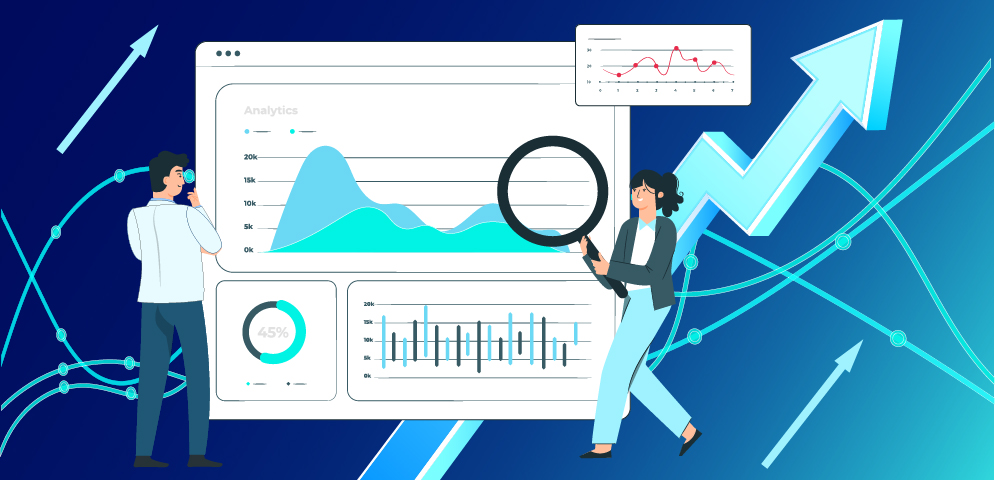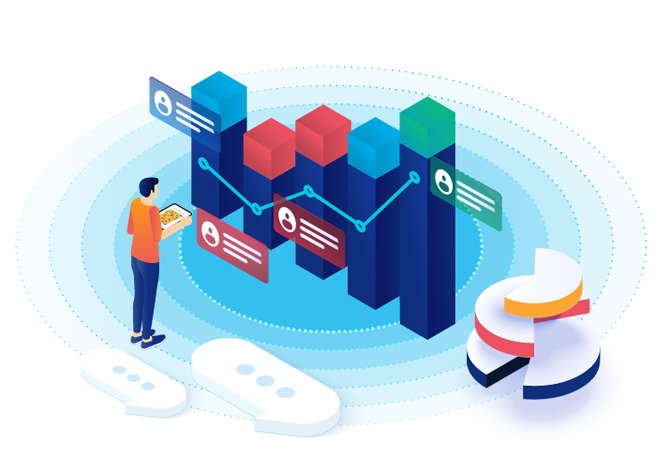In the ever-evolving landscape of business, staying ahead of the curve is not just an advantage; it’s a necessity. Market trend analysis has emerged as a crucial tool for businesses to understand, adapt, and thrive in dynamic market conditions. This article will delve into the depths of market trend analysis, exploring its intricacies, benefits, challenges, and prospects.
Market trend analysis is a comprehensive examination of market data to identify patterns, predict future trends, and make informed business decisions. Businesses across industries leverage this analytical approach to gain a competitive edge in the market. The significance of market trend analysis cannot be overstated, as it provides valuable insights into consumer behavior, industry shifts, and emerging opportunities.
Understanding Market Trends
1. Definition and Characteristics
At its core, a market trend is the general direction in which the market moves. It encompasses the collective behavior of consumers, industry players, and external factors that influence buying patterns. Identifying these trends requires a keen eye for changes in demand, preferences, and technological advancements.
2. Types of Market Trends
Market trends can manifest in various forms, from short-term fads to long-term shifts. Understanding the types of trends, whether they are product-related, consumer-driven, or influenced by external factors, is essential for effective analysis and strategic planning.
Market Trend Analysis Tools
To navigate the complex landscape of market trends, businesses employ an array of tools and techniques.
1. Data Analytics
The cornerstone of market trend analysis is data analytics. By harnessing the power of big data, businesses can uncover hidden patterns, correlations, and insights. Advanced analytics tools enable organizations to process vast amounts of data efficiently, providing a solid foundation for decision-making.
2. Artificial Intelligence in Market Analysis
Artificial Intelligence (AI) has revolutionized market trend analysis. Machine learning algorithms can analyze vast datasets, identify trends, and even predict future market movements. This technology not only enhances the accuracy of analysis but also reduces the time required to generate actionable insights.
3. Market Surveys and Research
Traditional methods, such as market surveys and research studies, remain invaluable in gathering qualitative data. Combining these approaches with quantitative analysis ensures a comprehensive understanding of market dynamics.
The Role of Technology in Shaping Market Trends
1. Impact of Digitalization
Digitalization has reshaped how businesses operate and how consumers interact with products and services. The integration of digital platforms, e-commerce, and online marketing channels significantly influences market trends. Businesses must adapt to these digital shifts to remain relevant and competitive.
2. Social Media Influence
The pervasive influence of social media cannot be ignored in market trend analysis. Platforms like Instagram, Twitter, and Facebook serve as real-time indicators of consumer sentiments and preferences. Monitoring social media trends provides businesses with timely insights into changing consumer behaviors.
Benefits of Market Trend Analysis
1. Informed Decision-Making
One of the primary benefits of market trend analysis is the ability to make well-informed decisions. By understanding current market dynamics and anticipating future trends, businesses can align their strategies to capitalize on opportunities and mitigate risks.
2. Risk Mitigation
Market trend analysis acts as a risk management tool. By identifying potential shifts in the market, businesses can proactively adjust their operations to minimize risks associated with changing consumer demands or economic fluctuations.
3. Competitive Advantage
Staying ahead of market trends gives businesses a competitive advantage. Those who can adapt quickly and align their offerings with evolving consumer preferences are more likely to outperform competitors in the long run.
Challenges
1. Data Accuracy and Reliability
Despite technological advancements, ensuring the accuracy and reliability of data remains a challenge. Inaccurate data can lead to flawed analyses and misguided business decisions. Businesses must invest in robust data validation processes to address this challenge.
2. Changing Consumer Behavior
Consumer behavior is inherently dynamic, influenced by cultural shifts, economic factors, and global events. Predicting and understanding these changes pose a continuous challenge for businesses engaged in market trend analysis.
Future Trends
1. Emerging Technologies
The future of market trend analysis holds exciting possibilities with emerging technologies like blockchain, augmented reality, and quantum computing. Businesses that embrace these technologies will likely gain a significant advantage in understanding and leveraging future market trends.
2. Predictive Analytics
Predictive analytics is set to play a more prominent role in market trend analysis. By using historical data and advanced algorithms, businesses can make predictions about future market movements with higher accuracy, enabling proactive decision-making.
Implementing Effective Market Trend Analysis Strategies
1. Tips for Businesses
Implementing effective market trend analysis requires a strategic approach.
- Regularly update analysis tools and techniques to stay relevant.
- Foster a data-driven culture within the organization.
- Collaborate with industry experts and thought leaders for diverse perspectives.
- Combine quantitative and qualitative data for a holistic understanding.
2. Hiring the Right Professionals
Investing in a skilled workforce is paramount for successful market trend analysis. Employing professionals with expertise in data science, analytics, and industry-specific knowledge ensures a robust analysis process.
The Global Impact of Market Trends on the Economy
1. Cross-Border Trends
Market trends are no longer confined by geographical boundaries. Businesses must pay attention to cross-border trends that impact global markets. Understanding international market dynamics is crucial for multinational corporations.
2. International Business Strategies
Adapting to global market trends requires strategic planning. International businesses must develop flexible strategies that account for cultural nuances, regulatory variations, and regional preferences.
Sustainability and Market Trends
1. Eco-friendly Practices
Sustainability is an increasingly important factor in market trends. Consumers are becoming more conscious of environmental impact, and businesses that prioritize eco-friendly practices are likely to gain favor among environmentally conscious consumers.
2. Consumer Preferences for Sustainable Products
The rising demand for sustainable products shapes market trends. Businesses should align their offerings with consumer preferences for environmentally friendly and ethically sourced products.
Adapting to Rapidly Changing Market Trends
1. Flexibility in Business Models
Rapid changes in market trends necessitate flexibility in business models. Companies that can quickly pivot their strategies in response to emerging trends are better positioned for long-term success.
2. Importance of Continuous Analysis
Market trend analysis is not a one-time effort but an ongoing process. Regularly revisiting and updating analyses ensures businesses remain attuned to evolving market dynamics.
The Role of Market Trend Analysis in Startups
1. Importance for New Businesses
Startups face unique challenges, and market trend analysis is instrumental in their survival and growth. Understanding market trends helps startups identify niche opportunities, differentiate themselves, and attract investors.
2. Strategies for Small Enterprises
Small enterprises can leverage trend analysis by focusing on targeted markets, monitoring consumer feedback, and staying agile in response to changing trends. Adaptability is key for small businesses aiming for sustained success.
Common Mistakes to Avoid
1. Overlooking Macro Trends
Focusing solely on micro trends can lead to oversight of broader macro trends that may have significant impacts. Businesses must balance attention to both micro and macro trends for comprehensive analysis.
2. Neglecting Regional Variations
Market trends can vary widely across regions. Neglecting regional variations may result in ineffective strategies. Businesses should tailor their approaches based on local preferences and market dynamics.
Case Studies with Record-Breaking Insights and Influencer Quotes
1. Case Study: Netflix’s Data-Driven Success
- Record-Breaking Insight: Netflix’s ability to predict market trends through data analytics played a significant role in their global dominance. By analyzing viewer behavior, Netflix not only tailors content but also anticipates future demand. This approach led to the launch of “Stranger Things,” which became a cultural phenomenon, breaking streaming records and significantly boosting subscriber numbers.
- Influencer Quote: Reed Hastings, CEO of Netflix, once tweeted, “Data doesn’t just tell us what happened—it can help us predict what will happen next. That’s the power of market trend analysis. #NetflixData #FutureReady”
2. Case Study: Tesla’s Embrace of Sustainable Market Trends
- Record-Breaking Insight: Tesla capitalized on the rising trend of sustainability and the shift towards electric vehicles (EVs). Their focus on eco-friendly innovation led to the Model 3 becoming the best-selling EV globally in 2020, with over 365,000 units sold, marking a significant shift in the automotive market.
- Influencer Quote: Elon Musk tweeted, “Sustainability isn’t just a trend, it’s the future. Those who align with it will lead. #Tesla #SustainableFuture”
3. Case Study: Apple’s Adaptation to Digitalization
- Record-Breaking Insight: Apple’s pivot to digital services, particularly the launch of Apple Music and Apple TV+, showed their ability to read market trends accurately. In 2019, Apple Music surpassed Spotify in the U.S., with over 28 million subscribers, setting a new standard in digital music consumption.
- Influencer Quote: Tim Cook shared, “Innovation at Apple is driven by the digital age. Understanding and adapting to digital trends keeps us ahead. #AppleInnovation #DigitalAge”
4. Case Study: Adidas’ Social Media Strategy
- Record-Breaking Insight: Adidas harnessed social media trends by launching viral campaigns like the “Create Your Own” series on Instagram, which boosted their online sales by 36% in 2018. Their ability to tap into social media’s power for real-time consumer insights has been a game-changer.
- Influencer Quote: Marketing expert Gary Vaynerchuk tweeted, “Brands like @adidas are winning by listening to the voice of the consumer on social media. Trend analysis isn’t just data—it’s dialogue. #Marketing #SocialListening”
5. Case Study: Unilever’s Focus on Sustainable Products
- Record-Breaking Insight: Unilever’s shift towards sustainability with brands like Dove and Ben & Jerry’s led to the company’s sustainable brands growing 69% faster than the rest of the business. This strategy contributed to over €1 billion in annual revenue by 2020.
- Influencer Quote: Paul Polman, former CEO of Unilever, stated, “The business case for sustainability is undeniable. Our market trend analysis shows it’s not just the right thing to do—it’s profitable. #SustainableBusiness #Unilever”
Conclusion
In conclusion, market trend analysis is a vital compass for businesses navigating the ever-changing marketplace. From understanding current consumer preferences to predicting future industry shifts, this analytical tool is indispensable for informed decision-making and long-term success. Embracing the challenges, leveraging emerging technologies, and adapting strategies will position businesses at the forefront of their respective industries.
Ready to elevate your market trend analysis? Request a demo from AIM Technologies today to experience cutting-edge solutions that will empower your business to thrive in dynamic markets.
FAQs
Is trend analysis relevant for small businesses?
- Yes, trend analysis is crucial for small businesses as it helps them identify opportunities, differentiate themselves, and adapt to changing market dynamics.
How often should businesses conduct trend analysis?
- Trend analysis should be a continuous process, with regular updates to ensure businesses stay informed about evolving trends.
What role does sustainability play in market trends?
- Sustainability is increasingly influencing market trends, with eco-friendly practices and sustainable products gaining traction among consumers.
Can trend analysis help startups attract investors?
- Yes, understanding market trends can make startups more attractive to investors by demonstrating a strategic approach and potential for growth.
What is the biggest mistake to avoid in trend analysis?
- Neglecting regional variations is a common mistake to avoid, as market trends can vary significantly across different regions.





